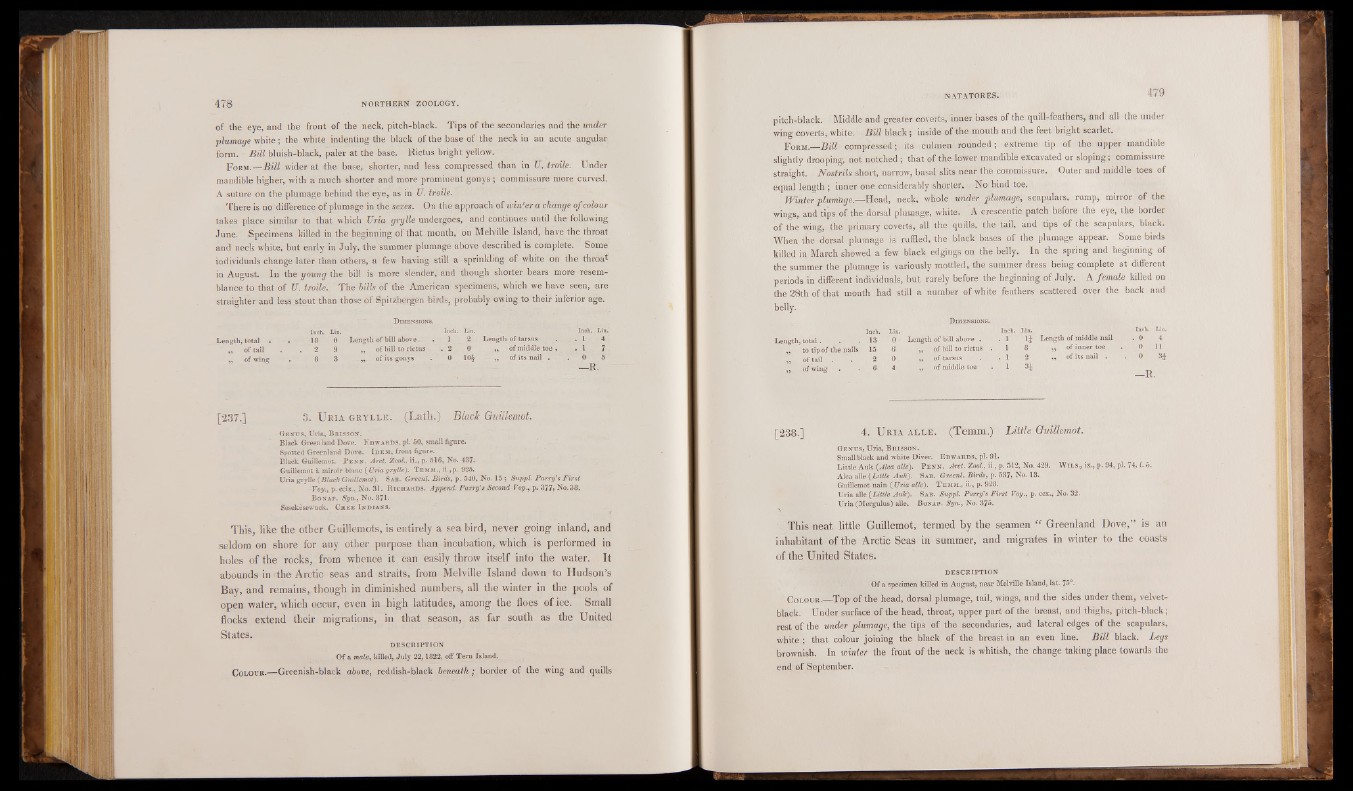
of the eye, and the front of the neck, pitch-black. Tips of the secondaries and the under
plumage white; the white indenting the black of the base of the neck in an acute angular
form. Bill bluish-black, paler at the base. Rictus bright yellow.
F orm.—Bill wider at the base, shorter, and less compressed than in U. troile. Under
mandible higher, with a much shorter and more prominent gonys; commissure more curved.
A suture on the plumage behind the"eye, as in U. troile.
There is no difference of plumage in the sexes. On the approach of winter a change o f colour
takes place similar to that which Uria grylle undergoes, and continues until the following
June. Specimens killed in the beginning of that month, on Melville Island, have the throat
and neck white, but early in July, the summer plumage above described is complete. Some
individuals change later than others, a few having still a sprinkling of white on the throat
in August. In the young the bill is more slender, and though shorter bears more resemblance
to that of U. troile. The bills of the American specimens, which we have seen, are
straighter and less stout than those of Spitzbergen birds, probably owing to their inferior age.
Dimensions.
..Inch. vLin.
1 4 nf tail . 2 9 ,, of bill to rictus 2 0 „ - of middle toe . . 1 7
( nf wing 8 3 . „ of its gonys 0 10£ ,, of its nail . . 0 5
Length, total •
Inch. Lin.
. 18 0 Length of bill above . .
Inch. Lin.
1 2 Length of tarsus . '
[237.] 3. U ria g r y l l e . (Lath.) Black Guillemot.
— R .
Genus, Uria, Brisson.
Black Greenland Dove. Edwards, pi.'50, small figure.
Spotted Greenland Dove. Idem, front figure.
Black Guillemot. Penn. Aret. Zool., ii., p. 516, No. 437.
Guillemot a miroir blanc (Uriagrylle). Temm., ii-,p- 925.
Uria grylle (Black Guillemot). Sab. Greenl. Birds, p. 540, No. 15; Suppl. Parry's First
Voy., p. ccix., No. 31. Richards. Append. Parry's Second Voy., p. 377, No. 38.
Bonap. Syn., No. 371-
Sesekesewuck. Cube Indians.
This, like the other Guillemots, is entirely a sea bird, never going inland, and
seldom on shore for any other purpose than incubation, which is performed in
holes of the rocks, from whence it can easily throw itself into the water. It
abounds in the Arctic seas and straits, from Melville Island down to Hudson’s
Bay, and remains, though in diminished numbers, all the winter in the pools of
open water, which occur, even in high latitudes, among the floes of ice. Small
flocks extend their migrations, in that season, as far south as the United
States. DESCRIPTION
Of a male, killed, July 22,1822, off Tern Island.
Colour.—Greenish-black above, reddish-black beneath; border of the wing and quills
pitch-black. Middle and greater coverts, inner bases of the quill-feathers, and all the under
wing coverts, white. Bill black; inside of the mouth and the feet bright scarlet.
F orm.—Bill compressed; its culmen rounded; extreme tip of the upper mandible
slightly drooping, not notched ; that of the lower mandible excavated or sloping; commissure
straight. .. Nostrils short, narrow, basal slits near the commissure. , Outer and middle toes of
equal length ; inner one considerably shorter. ■ No hind toe.
Winter plumage.— Head, neck,’ whole under plumage, scapulars, rump, mirror of the
wings, and tips of the dorsal plumage, white. A crescentic patch before the eye, the border
of the wing, the primary coverts, all the quills, the tail, and tips of the scapulars, black.
When the dorsal plumage is ruffled, the black bases of the plumage appear. Some birds
killed in March showed a few black edgings on the belly. In the spring and beginning of
the summer the plumage is variously mottled, the summer dress being complete at different
periods in different individuals, but rarely before the beginning of July. A female killed on
the 28th of that month had still a number of white feathers scattered over the back and
belly.
Inch. Lin.
Length, total. . . 1 3 0
,, to tip of the nails 15 6
„ oftail . 2 0
,, of wing • . 6 4
Dimensions.
Inch. Lin.
Length of bill above . . 1 1J
,, of bill to rictus . 1 8
„ of tarsus . . 1 2
„ of middle toe . 1 3J
Inch. Lin.
Length of middle nail . 0 4
„ of inner toe . 0 11 „ of its nail . . 0 3£
—R.
[238.] 4. U ria a l l e . (Temm.) Little Guillemot.
Genus, Uria, Brisson.
Small black and white Diver. Edwards, pi. 91.
Little Auk (Alca alle). Penn. Arct. Zool., ii., p. 512, No. 429. Wils., ix., p. 94, pi. 74, f- 5.
Alca alle (Little A u k). Sab. Greenl. Birds, p. 537, No. 13.
Guillemot nain (Uria alle). T emm., ii., p. 928.
Uria alle (Little Auk). Sab. Suppl. Parry's First Voy., p. ccx., No. 32.
Uria (Mergulus) alle. Bonap. Syn., No. 375.
This neat little Guillemot, termed by the seamen “ Greenland Dove,” is an
inhabitant of the Arctic Seas in summer, and migrates in winter to the coasts
of the United States.
DESCRIPTION
Of a specimen killed in August, near Melville Island, lat. 75°-
Colour.—Top of the head, dorsal plumage, tail, wings, and the sides under them, velvet-
black. Under surface of the head, throat, upper part of the breast, and thighs, pitch-black;
rest of the under plumage, the tips of the secondaries, and lateral edges of the scapulars,
white ; that colour joining the black of the breast in an even line. Bill black. Legs
brownish. In winter the front of the neck is whitish, the change taking place towards the
end of September.